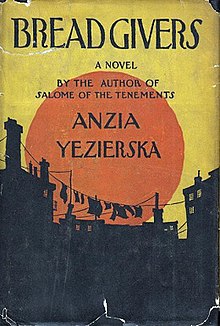Hester Street is a street in the Lower East Side of the New York City borough of Manhattan. It stretches from Essex Street to Centre Street, with a discontinuity between Chrystie Street and Forsyth Street for Sara Delano Roosevelt Park. There is also a discontinuity at Allen Street, which was created in 2009 with the rebuilding of the Allen Street Mall. At Centre Street, Hester Street shifts about 100 feet (30 m) to the north and is called Howard Street to its far western terminus at Mercer Street.

The Lower East Side, sometimes abbreviated as LES, is a historic neighborhood in the southeastern part of Manhattan in New York City. It is located roughly between the Bowery and the East River from Canal to Houston streets. Historically, it was understood to encompass a much larger area, from Broadway to the East River and from East 14th Street to Fulton and Franklin Streets.

Anzia Yezierska was a Jewish-American novelist born in Mały Płock, Poland, which was then part of the Russian Empire. She emigrated as a child with her parents to the United States and lived in the immigrant neighborhood of the Lower East Side of Manhattan.
Adele Wiseman was a Canadian author.

Salome of the Tenements is a 1925 American silent drama film adapted to the screen by Sonya Levien from the Anzia Yezierska novel of the same name. Made by Jesse L. Lasky and Adolph Zukor's Famous Players–Lasky Corporation, a division of Paramount Pictures, it was directed by Sidney Olcott and starred Jetta Goudal and Godfrey Tearle.

Call It Sleep is a 1934 novel by Henry Roth. The book is about a young boy growing up in the Jewish immigrant ghetto of New York's Lower East Side in the early 20th century.

Hester Street is a 1975 romantic film based on Abraham Cahan's 1896 novella Yekl: A Tale of the New York Ghetto, and was adapted and directed by Joan Micklin Silver. The film stars Steven Keats and Carol Kane, who was nominated for an Academy Award for Best Actress for the role of Gitl.
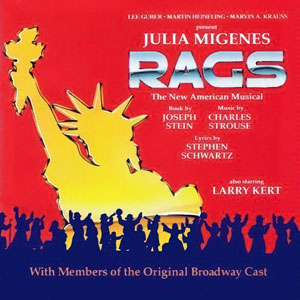
Rags is a musical with a book by Joseph Stein, lyrics by Stephen Schwartz, and music by Charles Strouse.
Cecelia Ager was an American film critic and star reporter for Variety and the New York Times Magazine.

Jennie Gerhardt is a 1911 novel by Theodore Dreiser.

The Sosnowiec Ghetto was a World War II ghetto set up by Nazi German authorities for Polish Jews in the Środula district of Sosnowiec in the Province of Upper Silesia. During the Holocaust in occupied Poland, most inmates, estimated at over 35,000 Jewish men, women and children were deported to Auschwitz death camp aboard Holocaust trains following roundups lasting from June until August 1943. The ghetto was liquidated during an uprising, a final act of defiance of its Underground Jewish Combat Organization (ŻOB) made up of youth. Most of the Jewish fighters perished.

Hungry Hearts (1922) is an American film based on stories by Anzia Yezierska about Jewish immigrants to the Lower East Side of New York City. The film was directed by E. Mason Hopper, produced by Samuel Goldwyn, and starred Helen Ferguson and E. Alyn Warren.
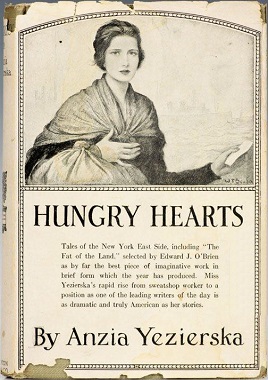
Hungry Hearts is a collection of short stories by Jewish/American writer Anzia Yezierska first published in 1920. The short stories deal with the European Jewish immigrant experience from the perspective of fictional female Jews, each story depicting a different aspect of their trials and tribulations in poverty in New York City at the turn of the 20th century. The stories were adapted into a film of the same name.
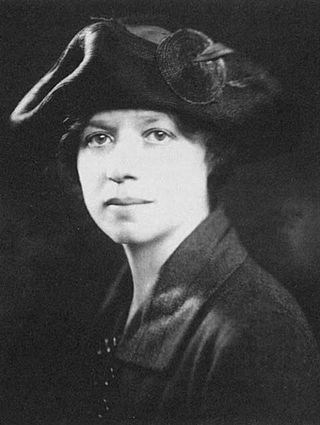
Rose Gollup Cohen (1880–1925) was a writer. She grew up in a village in the Russian Empire, immigrated to America with her aunt Masha in 1892 to join her father, and lived on New York City's Lower East Side. She worked in a garment sweatshop, joined a union, and also worked as a domestic servant. She suffered from poor health, and was at one point visited by Lillian Wald, who sent her to uptown Presbyterian Hospital, where she met people who sponsored summer outings for immigrant children. She then worked summers at a Connecticut retreat. Wald also referred her to a cooperative shirtwaist shop directed by Leonora O'Reilly, and when O'Reilly began teaching at the Manhattan Trade School for Girls in 1902, she recruited Cohen as her assistant.
An American immigrant novel is a genre of American novel which explores the process of assimilation and the relationship of American immigrants toward American identity and ideas. The novels often show and explore generational differences in immigrant families, especially the first and second generations. The extraordinary ethnic diversity of America allows for a type of immigrant novel which differs from other countries. America, often seen as a country of immigrants, opens up a unique canvas for expression and a better understanding of the American immigrant experience through literature. The narrative styles are diverse and can include memoirs, third-person, first-person, and biographies. The past twenty-five years alone have witnessed a major scholarly emphasis on multiculturalism in American studies, and a flood of new immigrant novels, reflecting the shifting demographics of United States immigration patterns.

The Adath Jeshurun of Jassy Synagogue and later, the Erste Warshawer Synagogue is a former Orthodox Jewish synagogue located at 58-60 Rivington Street near Eldridge Street on the Lower East Side of Manhattan, New York City, in New York, in the United States. The former synagogue was designed by architect Emery Roth, and completed in 1904 in the Moorish Revival style.

Suzanne Wasserman, was a Chicago-born historian, Professor, writer, and film director. Besides her tenure as Director of the Gotham Center for New York City history, she was also known for her first film, completed in 2003, Thunder in Guyana, which she wrote, produced, and directed. The film documented the life of her mother's first cousin, Chicago-born Janet Rosenberg Jagan, the president of Guyana from 1997 to 1999.

Salome of the Tenements is a novel published in 1922 by Jewish-American writer Anzia Yezierska. The novel follows the story of a young Jewish immigrant living in New York who wishes to marry a wealthy man and escape the bounds of her lower-class upbringing. Yezierska drew inspiration for the novel from the lives of Rose Pastor Stokes and her husband J. G. Phelps Stokes, as well as her own relationship with John Dewey. The novel was published by Boni & Liveright, and it was adapted into a film of the same name in 1925.
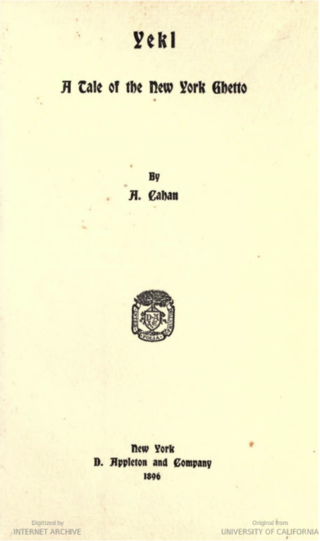
Yekl: A Tale of the New York Ghetto is Abraham Cahan's first book, published in 1896. It depicts the life of Jewish immigrants living in a New York City ghetto. The plot follows Yekl, Russian-Jewish immigrant sweatshop worker, as he attempts to assimilate into American culture. His attempts are complicated by the arrival of his wife and son, which force him to decide between his Jewish identity and a new American one.
Children of the Ghetto is an 1899 play written by British author Israel Zangwill. It is loosely based on Zangwill's 1892 novel of the same name. It is a drama in four acts, each with a subtitle and its own setting. The play is set around 1874, within the Jewish Quarter of London. The main plot centers on the love-affair of a young couple, thwarted from marrying by an obscure religious law and an unfortunate joke. The action of the play spans a hundred days time starting at Hanukkah.
